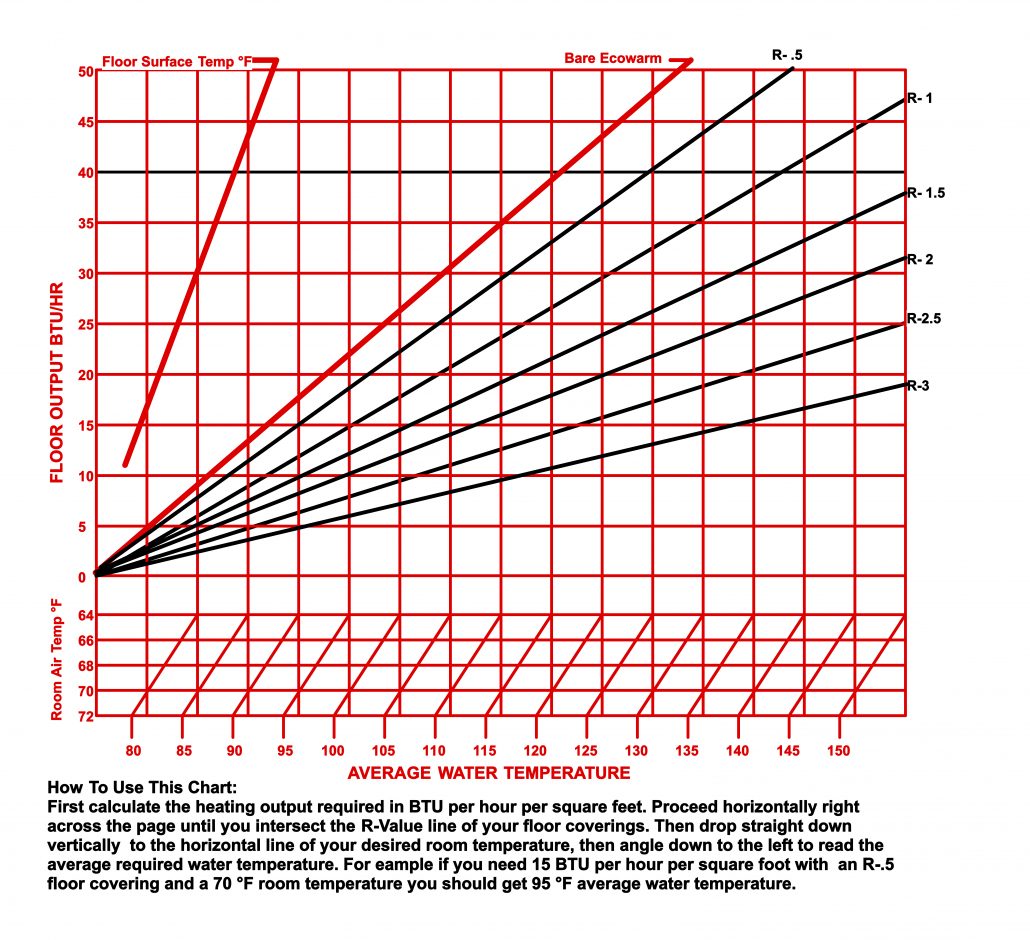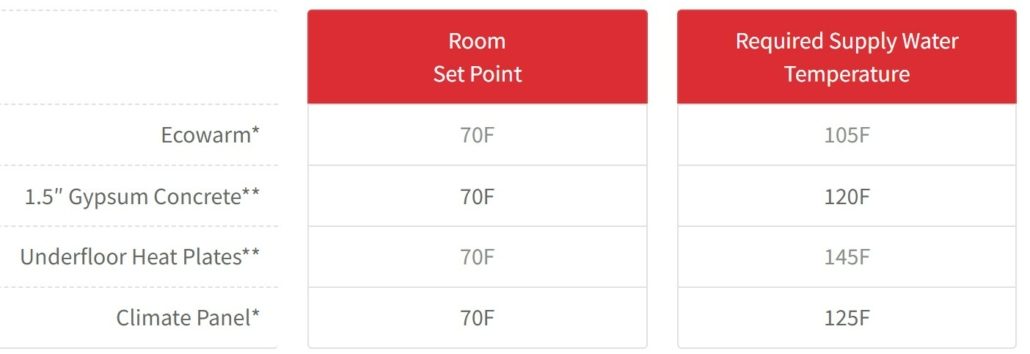People often ask the general question “Is radiant floor heating efficient”?
The general answer is “yes, generally speaking, radiant heat can be a more efficient heat delivery system than baseboard heat or forced air systems”
But all radiant heat delivery systems are not equally efficient…far from it.
Efficiency: The lower the supply water temperature required, the more efficient the heating system
The efficiency of a radiant floor thermal mass system is generally measured by the temperature of the supply water temperature required to meet the load of a space. That efficiency is determined by the level of heat transfer resistance experienced in the different radiant panel assemblies.
Response time is a separate measurement of performance indicating the speed a system can heat up and cool down.
Ecowarm Timelapse Video
*Note: The above video is an infrared timelapse of Ecowarm without the final flooring goods installed. Once the finished floor has been installed, you will see the heat spread evenly across the surface of the floor.
“Its pretty badass. If you’re in the market for radiant, I highly recommend looking into these guys. And maybe the best part, is that they are super nice to work with. You can check out my Deep Dive interview with them and you can just see how passionate they are about what they do…even after 30+ years in the business!” – Anthony Carrino
Good Heat Transfer Equals High Efficiency
The use of aluminum laminate on the surface of a RadiantBoard is critical to high performance. In our radiant heat panel design, we focused on the critical juncture of the radiant PEX tubing and the aluminum where surface area and quality of contact are critical, as with all heat exchangers.
PEX tubing carrying warm water is snapped into our patented overbite groove and expands very tightly into the channel for excellent heat transfer. The combination of aluminum laminate, tight contact between the tubing, and low board thermal mass results in excellent efficiency and a fast response time.
With our patented overbite design, tough PEX tubing is snapped or whacked into the groove with a small mallet. When warm water flows through the tubing it expands into the space, making a very tight heat transfer connection. The result is excellent performance.
How to Read Radiant Efficiency Charts
The chart below is a very common chart supplied by most manufacturers, used for designing radiant systems. It reveals the design efficiency of a given radiant flooring assembly (concrete, underfloor plates, Ecowarm etc). This type of common chart shows the supply water temperature required to radiant heat a space with a given heat loss with given types of flooring goods that provide various degrees resistance (R value) to upward heat flow. The lower the supply water temperature, the more efficient a radiant heat transfer system.
Example: Start at a heat requirement for the room (ex. 20 btu/hr/sq.ft) arrived at by a heat loss analysis shown on the X axis. Go to the right until you intersect the R value (resistance) of the flooring goods to be employed in the room (more on that below). Then go straight down and follow the slanted lines to the room temperature required, then straight down to the required supply water temperature.
Now we know the water temperature required to heat that space! You will see that number varies for different types of radiant heat transfer systems.
- Room
Set Point - Ecowarm*
- 1.5″ Gypsum Concrete**
- Underfloor Heat Plates**
- Climate Panel*
- Room
Set Point - 70F
- 70F
- 70F
- 70F
- Required Supply Water Temperature
- 105F
- 120F
- 145F
- 125F
*Source: Factory Supplied **Source: Zurn Design Manual
Systems Efficiency Comparison Charts
Performance Examples: Take a space requiring 20 btu/sq/ft with a finished floor of ¾” oak hardwood. Below are water temperature required to meet the heating load above.
Compare. Note the large variations of the efficiency between different radiant heat transfer assemblies.
The higher the required supply water temperature, the higher the life time operating costs for the radiant distribution assembly. This can mean many thousands of dollars in higher utility bills over the coming decades.
Flooring Goods R Values
Every finished flooring material put on top of a bare radiant heating floor creates resistance (R) to upward heat gain. The more resistance the higher the supply water temperature needs to be to meet the heat loss of the space.
Most people don’t realize that the flooring goods are an important variable in the radiant heating design. Generally speaking, the denser the type of flooring goods the less resistance. Tile and stone – not very much resistance. Carpet and carpet pad. Ouch.
When using higher R value flooring goods like carpet and thick hardwood it is very helpful to have a high efficiency system like Ecowarm to compensate for the high resistance of these flooring goods.
Response Rate: Nimble Response
Ecowarm RadiantBoard heats up and cools downs rapidly with its low thermal mass and aluminum surface.
Faster Than Concrete and Underfloor Plate Systems
Ecowarm’s radiant panels heat up six times faster than concrete and far faster than underfloor plate systems.
With the use of setback thermostats and outdoor reset controls this makes for a very responsive system. Get heat when you want it.
Contact Us Today For a Free Quote!
Ecowarm RadiantBoard incorporates the best balance of high performance, material quality, environmental responsibility, and cost. In short, Ecowarm RadiantBoard represents the best value in radiant board heating systems.






